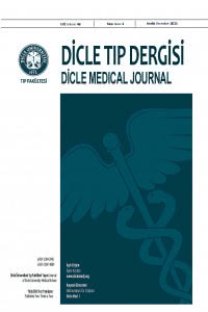Child maltreatment: Abuse and neglect
Çocuklara kötü muamele: İstismar ve ihmal
___
- 1. Preventing child maltreatment: a guide to taking action and generating evidence /World Health Organization and International Society for Prevention of Child Abuse and Neglect, 2006
- 2. McDonald KC. Child Abuse: Approach and Management. Am Fam Physician 2007;75:221–8
- 3. Krug EG et al., eds. World report on violence and health. Geneva, World Health Organization, 2002.
- 4. Physical Punishment in Childhood: The Rights of the Child Bernadette J.Saunders, Chris Goddard, John Willey and Sons, 2010.
- 5. Department of Health and Human Services, Administration on Children, Youth, and Families. Child Maltreatment 2006 [online]. Washington (DC): Government Printing Office; 2006. [cited 2008 Feb 20]. Available from: www.acf.hhs.gov.
- 6. Information from Wang CT, Daro D. Current trends in child abuse reporting and fatalities: the results of the 1996 annual fifty state survey. Chicago: National Committee to Prevent Child Abuse, 1997.
- 7. National Child Abuse and Neglect (CAN) Statistics, Arizona Child Abuse and Neglect Center Available from: http://childhelpinfocenter.org
- 8. Rosenberg LA. Effects of maltreatment on the child. In: Wissow LS, ed. Child Advocacy for the Clinician: An Approach to Child Abuse and Neglect. Baltimore, Md.: Williams & Wilkins, 1990:12.
- 9. Bethea L. Primary prevention of child abuse. American Family Physician; March 15, 1999; 59(6).
- 10. Innocenti Report Card Issue No. 3 September 2003, UNICEF Innocenti Research Centre, Florence. Available from: www.unicef-icdc.org
- 11.Runyan D, Wattam C, Ikeda R, Hassan F, Ramiro L. Child abuse and neglect by parents and caregivers. In: Krug E, Dahlberg LL, Mercy JA, Zwi AB, Lozano R, editors. World Report on Violence and Health. Geneva, Switzerland: World Health Organization; 2002. p. 59–86. Available from: www.who.int/violence_injury_prevention/violence/global_campaign/en/chap3.pdf
- 12. Pressel DM. Evaluation of physical abuse in children. Am Fam Physician 2000;61:3057-64.
- 13. Department of Health and Human Services (DHHS), Administration on Children, Youth, and Families (ACF). Emerging practices in the prevention of child abuse and neglect. Washington (DC): Government Printing Office; 2003. Available from: www.childwelfare.gov/preventing/programs/whatworks/report/report.pdf.
- 14. Understanding Child maltreatment Factsheet 2009 Available from: http://www.cdc.gov/violenceprevention/pdf/CM-FactSheet-a.pdf
- 15. Tıraşçı Y, Gören S. Çocuk istismarı ve ihmali. Dicle Tıp Derg 2007;34:70-74
- ISSN: 1300-2945
- Yayın Aralığı: 4
- Başlangıç: 1963
- Yayıncı: Cahfer GÜLOĞLU
Psöriazisli hastalarda deri lezyonlarında T hücreleri ve periferik kanda sitokin düzeyleri
İbrahim KÖKÇAM, Nursel DİLEK, Ahmet GÖDEKMERDAN, Nusret AKPOLAT, NAFİYE FULYA İLHAN
Konjenital blefaroptozisli olgularda levator palpebra superior kasının histolojik değerlendirmesi
Sevda SÖKER, Sevin ÇAKMAK, Murat AKKUŞ, YUSUF NERGİZ
Elif DOĞAN, AYŞE KEFELİ, Yaşar NAZLIGÜL, ABDULLAH ÖZGÜR YENİOVA, Metin KÜÇÜKAZMAN, Zeynep ÇİZMECİ, Servet GÜREŞÇİ, CİHAN FİDAN
Hemşirelerin iletişim becerileri: Samsun ili örneği
Hatice KUMCAĞIZ, MÜGE YILMAZ, Seher Balcı ÇELİK, İlknur Aydın AVCI
Differential diagnosis of a cavitary lung lesion in 45-year old man
Tanseli GÖNLÜGÜR, Feride SAPMAZ, Uğur GÖNLÜGÜR, Şahende ELAGÖZ
Diklofenak ve parasetamolun intihar amaçlı kullanımına bağlı subkonjonktival kanama gelişen iki olgu
Esra YILDIZHAN, Ali KUTLUCAN, Adem GÜNGÖR, Cağrı KILIÇ, Hayati KANDİŞ
Servikal lenfadenit nedeni olarak tularemi
Ahmet EYİBİLEN, Adnan EKİNCİ, İbrahim ALADAĞ
Child maltreatment: Abuse and neglect
Bengü PALA, Murat ÜNALACAK, İLHAMİ ÜNLÜOĞLU
Miyokardiyal “noncompaction”: İki olgu
MECNUN ÇETİN, Münevver YILDIRIMER, Adnan Taner KURDAL, Şenol COŞKUN
İshalli çocuklarda Cryptosporidium spp. ve diğer barsak parazitlerinin yaygınlığı
